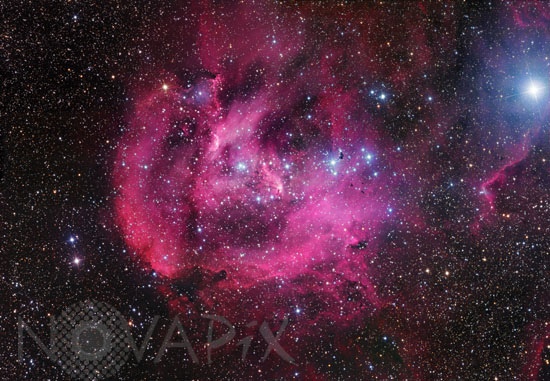Photo Agency - Astronomy - Space - Nature

A large southern emission nebula, IC 2948
author: R.Gendler/Novapix
reference: a-nec29-48003
Image Size 300 DPI: 63 * 44 cm
IC2944 is a large HII region (star forming cloud) in the southern constellation of Centaurus. The bright blue star in the upper right is Lambda Centauri, one of the brightest stars in the southern sky.The cluster of hot blue stars to the right of center are illuminating the gases of IC2944 and causing it to glow in the red and magenta light of excited hydrogen. The compact black objects adjacent to the bright blue stars are called Thackeray's Globules named for the astronomer A.D. Thackeray who described these in 1950. Thackeray Globules are similar to Bok Globules which are compact dark structures first described by the astronomer Bart Bok (1906-1983) in the 1940's. Bok Globules are small dark clouds of gas and dust that are found in HII regions and typically have a mass of about 10 to 50 solar masses. They often span a region of about one light year across. Their contents are predominantly molecular hydrogen, carbon oxides and helium but also contain about small amounts (1%) of silicate dust. Infrared observations in the 1990's detected the existence of protostars within the dense confines of Bok globules confirming the hypothesis of Bok, who strongly believed that these globules represented cocoons of starbirth. The larger Bok Globules seen in the image are about 1.4 light years across and contain enough mass to make 15 suns.
Four Frame Mosaic, Total Exposure 28 Hours
14.5" RCOS telescope.
Four Frame Mosaic, Total Exposure 28 Hours
14.5" RCOS telescope.
Keywords for this photo:
2008 - ASTRONOMY - BOK GLOBULE - CENTAURUS - EMISSION NEBULA - IC 2944 - IC 2948 - NEBULA - POSTER - SOUTHERN HEMISPHERE - STAR - STAR FORMATION - YOUNG STAR -
Contact : Stéphane Aubin +33-(0)9-51-26-53-76
© Novapix - All rights reserved


